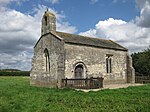Lotherton Hall is a country house near Aberford in West Yorkshire, England. It is a short distance from the A1(M) motorway, 200 miles (320 km) equidistant from London and Edinburgh. It is one of nine sites in the Leeds Museums & Galleries group.
A manor house has occupied the site of the hall from at least 1775, when it appears on Thomas Jeffery's map of Yorkshire. The house was owned by Thomas Maude, who brought it from George Rhodes in 1753 for £4,115. Ownership then passed to Wollen and then to John Raper. In 1824 John Raper died and his son and heir, John Lamplugh Raper, sold the property to Richard Oliver Gascoigne in 1825. After Richard Oliver Gascoigne's death in 1842, Lotherton was inherited by his unmarried daughters, Elizabeth and Mary Isabella. Richard Trench Gascoigne took up ownership of the house in 1893 following the death of his aunt Elizabeth who had married Lord Ashtown. It became the main residence of the Gascoigne family after the death of Richard's father Frederick at Parlington Hall in 1905. Between 1914 and 1918, the Hall was used as a V.A.D. hospital. A 12th-century Norman chapel in the grounds, in use until 1830, was renovated between 1913 and 1917 and used as part of the V.A.D. hospital.The hall is on the Gascoigne estate, and was presented to the City of Leeds in 1968 by Sir Alvary Gascoigne and his wife, last of the Gascoigne family, whose roots were at Parlington Hall. The hall and parkland were opened for public access on 6 August 1969, exactly 25 years after Sir Alvary Gascoigne's only son and heir, Douglas Gascoigne, was killed in a tank battle in Normandy. The estate is home to a collection of endangered bird species and a herd of red deer. There is a large expanse of grassland in front of the bird garden, typically used during the summer months for ball games and picnics. Another field is used to host shows, such as an annual motorcycle show.
The hall was extensively rebuilt during the Victorian and Edwardian eras. It holds an art collection that includes the Gascoigne Gift, given to the City of Leeds along with the hall, which sits alongside collections of fine and decorative arts added to the collection since becoming a museum in 1968.The hall is licensed to hold wedding and civil partnership ceremonies.











